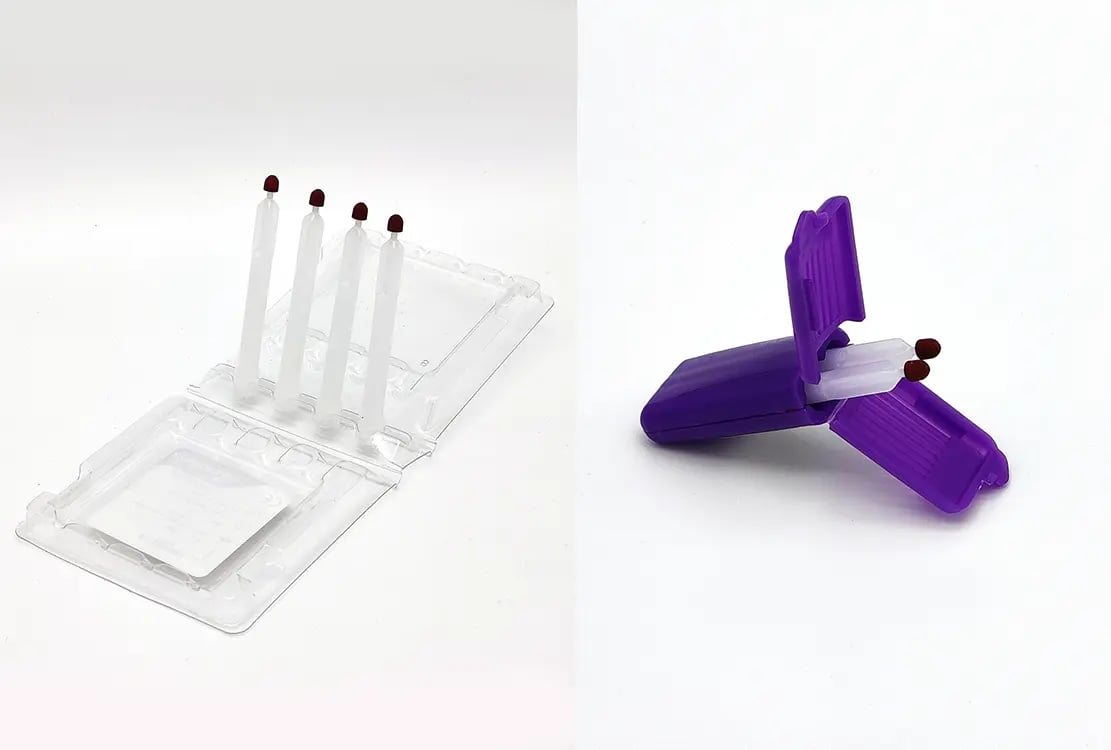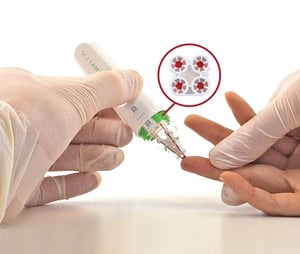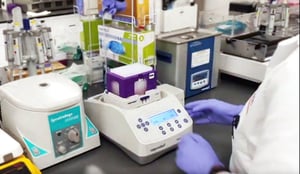Share this
microsampling research: analytes that are challenging to measure from dried blood
by James Rudge, PhD, Technical Director, Neoteryx on May 5, 2022 9:30:00 AM
Finger-stick collection of capillary blood for dried sample analysis is a highly convenient and minimally invasive alternative to conventional phlebotomy. With the increased availability of remote specimen collection tools like Mitra® devices based on VAMS® technology, hemaPEN® based on precision DBS, and other user-friendly options, the ability to capture a quantitative blood sample from virtually anywhere has broadened the scope for research.
Numerous research institutions have already adopted these devices for “remote microsampling studies” where study volunteers can participate by self-collecting their own samples at home.

Areas of Research Where Dried Blood Samples Are Useful
There are now more than 200 manuscripts in the research literature that describe highly successful validations and clinical studies using dried blood samples that were remotely collected with Mitra-VAMS devices or the hemaPEN. The studies include therapeutic drug monitoring on both small and large drugs.
Microsampling devices have also shown great utility in pharmacokinetics for pharmaceutical pre-clinical studies and clinical trials. Increasing success in these areas has allowed for more studies to onboard dried blood sampling for new drug trials. Also, the Covid-19 pandemic illustrated the utility of remotely collected samples on serological research assays and in so doing, has helped to validate the approach for other related assays.
Additionally, there have been several research papers focused on using remote sampling for therapeutic drug monitoring (TDM). Further, research into clinical toxicology and sports doping have shown that these devices can be used not only for measuring traditional drugs but also can be used for measuring biological doping agents such as transgene vectors.
Research investigations into biomarkers have, in recent years, shown that dried blood samples collected with devices based on volumetric absorptive microsampling can be used for measuring specific analytes. For example, studies measuring hormones and other current biomarkers such as creatinine, HbA1c (specific analyzers only), and thiamine have shown promise using dried Mitra-VAMS samples.
Moreover, there have been great strides gained in novel biomarker research. For example, papers using Mitra-VAMS and hemaPEN samples have been published in the fields of molecular diagnostics, proteomics and metabolomics. Finally, there has been interest in using dried blood samples for research into environmental and biological toxins, such as metals and exposure to ‘forever’ chemicals like Per- and Polyfluoroalkyl Substances (PFAS) that may be found in drinking water and household items.
The list of programs in which dried blood sampling can be applied continues to grow as research scientists become increasingly skilled in handling microsamples and as analytical instruments and techniques becoming increasingly more specific and sensitive.
Limitations of Dried Blood Microsamples for Whole Blood Research Assays
Given the surprising variety of research assays that have shown utility on Mitra devices with VAMS and on the HemaPEN, it may be surprising to know there are certain limitations that prevent dried blood microsamples being used to measure all analytes. There are two primary reasons for this.
- Physiological incompatibility: Where the drying and processing of blood damages the analytes in the matrix (or damages the matrix itself) in such a way that they are not measurable in any meaningful way — or even at all!
- Analytical incompatibility: Where current / popular instrumentation is incompatible with microsamples and or dried blood extracts. An example of this is common blood tests such as liver function enzymes and lipids, which are measured using clinical chemistry analyzers.
Popular Assays Currently Incompatible with Dried Blood Microsamples
Below is a list of some of the common assays that are currently incompatible with dried blood samples.
1. Serum lipids such as cholesterol LDL and HDL: Cell walls contain cholesterol and when dried blood is hydrated, the cells lyse. In doing so, the cells spill lipids into the serum, causing a false-positive result. The measurement of apolipoproteins may become an alternative approach for the measurement of cholesterol or LDL/HDL from dried blood samples for assessing cardiac risk. However, these do not fully correlate with standard lipid biomarkers and so are not yet standard practice.
2. Whole blood count / fraction: Typically, blood counts are measured using flow cytometry and require intact cells. Drying and rehydrating whole blood lyses cells, destroying the sample for analysis.
3. Liver function: The most popular assay for measuring liver function is to measure enzymes, released by the liver into the blood when damaged. This assay requires centrifugation of clotted blood to form serum (a clear liquid). Following this, a substrate is added to the serum, which reacts specifically with the liver enzyme to produce a pigmented product that can then be measured with spectrophotometry.
Dried blood, when hydrated, is fully lysed. Even after centrifugation, the extract is highly pigmented (primarily with hemoglobin). This leads to false positives in the assay.
A further complication that may occur when measuring some enzymes (such as the liver enzyme Aspartate transaminase for example) is that these can also be found in red blood cells. Cell lysis from the extraction step will act to spill these enzymes into the sample matrix leading to further false positives when compared to serum where the cellular contents are removed by centrifugation prior to sampling.
There are however attempts to find new omics markers that could be compatible with dried blood, but these are still at the experimental stage.
4. Serum electrolytes: Two key electrolytes in blood are sodium (Na) and potassium (K). The body pumps K into cells and Na into the plasma while maintaining a constant osmotic balance. Lysing cells from dried blood extracts release cellular K into the serum, causing a significant false-positive when conducting an electrolyte test.
5. Vitamins: Vitamin D and B1 have been successfully evaluated on Mitra devices. However, vitamins are typically very difficult to measure. This is partly a result of their antioxidant properties. In short, they risk oxidative degradation in the dried matrix.
6. Metals: There have been several papers published on Mitra devices with VAMS used for metal analysis in blood samples taken from people who had received metal prostheses. Some papers have shown successful validations, including a recent paper measuring mercury.
However, surfaces (including the surfaces of VAMS tips on Mitra devices) are easily contaminated with metals, so high background levels of other metals such as lead, have been reported by experts analyzing Mitra samples. There are ways to mitigate this, but it is important to consider contamination before embarking on research of metals on dried blood samples.
Concluding Thoughts on Measuring Analytes From Dried Blood
As a rule of thumb, if you are looking to develop a method using dried matrix sampling, then either LC-MS/MS or ligand binding assays are often the best place to start. Due to good sample clean-up before analysis, these techniques often allow for analysis from much more complicated matrices, such as whole dried blood extracts.
However, if there are physiological reasons why dried blood samples are incompatible (such as K), then even these techniques will not help. As a result of these challenges, wet blood assays are the only realistic alternative for many analytes.
To develop a greater understanding of what is possible with dried blood assays and how to develop methods for these, please look at these resources (24, 25, 26, 27) in the list of source links below.
Source Links:1. https://www.neoteryx.com/analytes-detected-vams-microsampling
2. https://www.future-science.com/doi/10.4155/bio-2021-0102
3. https://pubmed.ncbi.nlm.nih.gov/33675301/
4. https://www.mdpi.com/1424-8247/14/7/627
5. https://www.sciencedirect.com/science/article/abs/pii/S0021967320307214
6. https://academic.oup.com/jat/article-abstract/45/6/581/5901577?redirectedFrom=fulltext
7. https://www.neoteryx.com/microsampling-blog/using-mitra-with-vams-to-monitor-steroid-hormone-levels
8. https://www.neoteryx.com/microsampling-blog/using-vams-to-measure-drug-level-and-renal-function
9. https://hubs.ly/H0TDCpt0
10. https://pubs.acs.org/doi/10.1021/acs.analchem.0c05018
11. https://www.neoteryx.com/microsampling-blog/mitra-and-dbs-used-in-epo-transgene-doping-detection
12. https://pubmed.ncbi.nlm.nih.gov/30198258/
13. https://www.ncbi.nlm.nih.gov/pmc/articles/PMC7261863/
14. https://www.sciencedirect.com/science/article/pii/S2376999817300181
15. https://pubmed.ncbi.nlm.nih.gov/35166117/
16. https://pdfs.semanticscholar.org/32c0/8e5eb6139b1a1472105bf19b6a2d8acb38b0.pdf?_ga=2.65168046.1481408193.1579541298-743611297.1579541298
17. https://orbi.uliege.be/handle/2268/268010
18. https://www.sciencedirect.com/science/article/abs/pii/S0003269718300241?via%3Dihub
19. https://www.sciencedirect.com/science/article/abs/pii/S0952327819300523
20. https://www.future-science.com/doi/abs/10.4155/bio-2020-0012
21. https://pubmed.ncbi.nlm.nih.gov/27692372/
22. https://link.springer.com/article/10.1007/s10661-022-09962-1
23. https://hubs.ly/H0_RrQb0
24. https://www.sciencedirect.com/science/article/abs/pii/S0003267018310626?via%3Dihub
25. https://pubmed.ncbi.nlm.nih.gov/31268966/
26. https://pubmed.ncbi.nlm.nih.gov/31218897/
Image Credits: Neoteryx, Trajan Scientific and Medical

Share this
- Microsampling (205)
- Research, Remote Research (118)
- Venipuncture Alternative (106)
- Clinical Trials, Clinical Research (82)
- Mitra® Device (72)
- Therapeutic Drug Monitoring, TDM (50)
- Dried Blood Spot, DBS (38)
- Biomonitoring, Health, Wellness (31)
- Infectious Disease, Vaccines, COVID-19 (24)
- Decentralized Clinical Trial (DCT) (22)
- Blood Microsampling, Serology (21)
- Omics, Multi-Omics (19)
- Specimen Collection (17)
- Toxicology, Doping, Drug/Alcohol Monitoring, PEth (17)
- hemaPEN® Device (13)
- Preclinical Research, Animal Studies (12)
- Pharmaceuticals, Drug Development (9)
- Harpera® Tool (6)
- Industry News, Microsampling News (5)
- Skin Microsampling, Microbiopsy (5)
- Company Press Release, Product Press Release (4)
- Antibodies, MAbs (3)
- Environmental Toxins, Exposures (1)
- April 2024 (4)
- March 2024 (1)
- February 2024 (2)
- January 2024 (4)
- December 2023 (3)
- November 2023 (3)
- October 2023 (3)
- September 2023 (3)
- July 2023 (3)
- June 2023 (2)
- April 2023 (2)
- March 2023 (2)
- February 2023 (2)
- January 2023 (3)
- December 2022 (2)
- November 2022 (3)
- October 2022 (4)
- September 2022 (3)
- August 2022 (5)
- July 2022 (2)
- June 2022 (2)
- May 2022 (4)
- April 2022 (3)
- March 2022 (3)
- February 2022 (4)
- January 2022 (5)
- December 2021 (3)
- November 2021 (5)
- October 2021 (3)
- September 2021 (3)
- August 2021 (4)
- July 2021 (4)
- June 2021 (4)
- May 2021 (4)
- April 2021 (3)
- March 2021 (5)
- February 2021 (4)
- January 2021 (4)
- December 2020 (3)
- November 2020 (5)
- October 2020 (4)
- September 2020 (3)
- August 2020 (3)
- July 2020 (6)
- June 2020 (4)
- May 2020 (4)
- April 2020 (3)
- March 2020 (6)
- February 2020 (3)
- January 2020 (4)
- December 2019 (5)
- November 2019 (4)
- October 2019 (2)
- September 2019 (4)
- August 2019 (5)
- July 2019 (3)
- June 2019 (7)
- May 2019 (6)
- April 2019 (5)
- March 2019 (6)
- February 2019 (5)
- January 2019 (8)
- December 2018 (3)
- November 2018 (4)
- October 2018 (7)
- September 2018 (6)
- August 2018 (5)
- July 2018 (8)
- June 2018 (6)
- May 2018 (5)
- April 2018 (6)
- March 2018 (4)
- February 2018 (6)
- January 2018 (4)
- December 2017 (2)
- November 2017 (3)
- October 2017 (2)
- September 2017 (4)
- August 2017 (2)
- July 2017 (4)
- June 2017 (5)
- May 2017 (6)
- April 2017 (6)
- March 2017 (5)
- February 2017 (4)
- January 2017 (1)
- July 2016 (3)
- May 2016 (1)
- April 2016 (2)


No Comments Yet
Let us know what you think